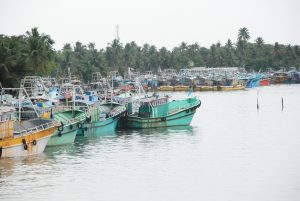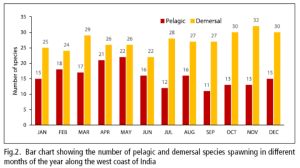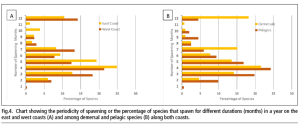An analysis of spawning periods of marine fish resources along both India’s west coast and east coast reveals differences in the peak spawning periods for pelagic and demersal stocks
This article is by Mohamed K S (ksmohamed@gmail.com), Sathianandan T V (tvsedpl@gmail.com) and Vivekanandan E (evivekanandan@hotmail.com), Former researchers of the Central Marine Fisheries Research Institute, Kochi, India
A new analysis of the spawning period of species along both the coasts of India suggests it may be appropriate to review the timing of the seasonal closure of marine fisheries in India.
The analysis is based on 526 historic fish and shellfish spawning records over a 64-year period, on Indian fisheries in the Arabian Sea and the Bay of Bengal between 1954 and 2018. The spawning records on 129 species are contained in the Indian Marine Life Histories (INMARLH) database. Its analysis revealed that along the west coast, 69 per cent of the species spawn during the April-May period and 65 per cent in the November-December period. Along the east coast, 68 per cent spawn during March-April. There were differences in the peak spawning periods for pelagic and demersal stocks along both coasts.
… the spawning periods of most species are timed in a manner that the progeny—larvae and juveniles—begin their life when there is maximum primary productivity in the seas
Spawning refers to the reproductive process of fishes, where they release their eggs and sperm into the water to fertilize and produce offspring. It is an essential part of their life cycle and ensures the continuation of their species. The specifics of spawning can vary from species to species, sometimes significantly. It is influenced by the physiological and biological state of the animal, environmental cues and favourable ecosystems, among other factors.
In India, the spawning period or peak period of spawning of important marine finfish and shellfish resources has been relatively well-studied for the past several decades; several insightful reviews are also available. However, the methodologies applied to these studies are varied and, often, subject to inaccuracies. Since Indian seas are situated in tropical and subtropical latitudes, the finfish and shellfish resources, in general, have short life spans, fast growth and protracted spawning periods with peaks. Information on spawning and other biological attributes of marine finfish and shellfish resources have been recently collated into a database called INMARLH, available from a public repository. This analysis draws from this database to determine the spawning pattern of Indian commercial marine fishes.

This database is a collection of biological and fisheries information on marine fish and shellfish species published in research journals and reports between 1954 and 2018. The database contains 3,132 records on 644 fish stocks from the four coastal eco-regions of India, namely, northwest, southwest, southeast and northeast. The 644 stocks belonged to 133 species; 90 genera; 55 families and 19 orders. INMARLH contains information on the number of spawning months in a year of 129 species. They were further classified into those off the west coast (76 species) and those off the east coast (53 species). Based on the realm of occurrence, they were further categorized into pelagic (50 species) and demersal (79 species). All analyses were carried out using spreadsheets.

Zooming out
The analysis of data shows that spawning occurs in all the months of the year. Along the west coast, 69 per cent of the species spawn at their maximum during March-May; a secondary peak of 65 per cent of the species is observed during November-December. The least number of species, 55 per cent, spawn during the monsoon period of June-September.
 The difference between the maximum and minimum percentages is small. The relatively lower number of species spawning during the southwest monsoon may also be due to poor sampling during the monsoon season. Off the east coast, the maximum number of species spawning observed during March-April was 68 per cent and a secondary peak of 57 per cent was seen in February-May. The least number of species spawning was 30 per cent, observed in September.
The difference between the maximum and minimum percentages is small. The relatively lower number of species spawning during the southwest monsoon may also be due to poor sampling during the monsoon season. Off the east coast, the maximum number of species spawning observed during March-April was 68 per cent and a secondary peak of 57 per cent was seen in February-May. The least number of species spawning was 30 per cent, observed in September.

When the data is examined coast-wise and realm-wise, the results show a similar trend for both coasts. This is apparent in the month-wise data of pelagic and demersal species spawning along the west coast (see Figure 2). The largest number of demersal species spawning is 72 per cent in October-December. The minimum number of demersal species spawning was 51 per cent in June. In the case of pelagic species, the maximum number of spawning species observed was 83 per cent in April-May; the minimum was 26 per cent in September. The difference between maximum and minimum in both demersal and pelagic species was significant, sometimes more than double.

 Off the east coast, the spawning of demersal species peaked at 67 per cent in March-April; the lowest point observed was 43 per cent during September (see Figure 3). In the case of pelagic fish stocks, also, the maximum was 90 per cent observed during March-April; the minimum of 14 per cent occurred in September. The difference between maximum and minimum was substantial on the east coast in the case of pelagic and demersal stocks.
Off the east coast, the spawning of demersal species peaked at 67 per cent in March-April; the lowest point observed was 43 per cent during September (see Figure 3). In the case of pelagic fish stocks, also, the maximum was 90 per cent observed during March-April; the minimum of 14 per cent occurred in September. The difference between maximum and minimum was substantial on the east coast in the case of pelagic and demersal stocks.
Our observations indicate that, in general, the spawning periods of most species are timed in a manner that the progeny—larvae and juveniles—begin their life when there is maximum primary productivity in the seas. This is especially evident along the west coast for both pelagic and demersal during the southwest monsoon. For demersal species, a clear secondary peak spawning occurs after the monsoon in November-December, probably timed to catch the secondary production peak during the pre-monsoon period.
These inferences need to be confirmed with more detailed studies on the life cycles of individual species. Also examined was the periodicity of spawning, that is, the number of months each species spawns. It was observed that the maximum number of species, 15-25 per cent, spawn for three to four months in a year along both the east and west coasts of India. Another 10-15 per cent of the species spawn for seven months and throughout the year. When the data was analysed, it was observed that 61 per cent of pelagic species had relatively shorter spawning periods of three to five months, while 58 per cent of the demersal species had comparatively longer spawning periods of four to seven months. More importantly, 18.2 per cent of the demersal species were spawning throughout the year.

The application
Protecting the spawning periods of fish is crucial for the conservation and sustainability of fish populations and marine ecosystems. To protect spawning periods effectively, it is important to establish and enforce regulations that restrict harmful activities during these times. This may involve implementing fishing bans, establishing protected areas, improving water quality, and minimizing disturbances to spawning habitats.
Some of the objectives for conservation are:
While all points in the above list are important, preventing the fourth or recruitment over-fishing is the main basis on which India implements a seasonal fishing ban along both the east and west coasts. The ban is for 61 days from 15 April to 14 June along the east coast and 1 June to 31 July along the west coast.
Conservation managers and fisheries policymakers may consider this information to revise the ban period and promote more effectively the long-term sustainability of marine fish populations in India. It is also important to remember that biological information on species is always dynamic and subject to better understanding with time.
For more
Indian Marine Fish Life Histories (INMARLH) database for determining resilience and vulnerability of tropical marine species
https://www.seanoe.org/data/00709/82124/
An appraisal of the studies on maturation and spawning In marine teleosts from the Indian waters
https://eprints.cmfri.org.in/1230/
Application of biological and fisheries attributes to assess the vulnerability and resilience of tropical marine fish species
https://journals.plos.org/plosone/article?id=10.1371/journal.pone.0255879
Seasonal Fishing Ban: Need for collecting and applying the right type of scientific information
https://eprints.cmfri.org.in/14319/